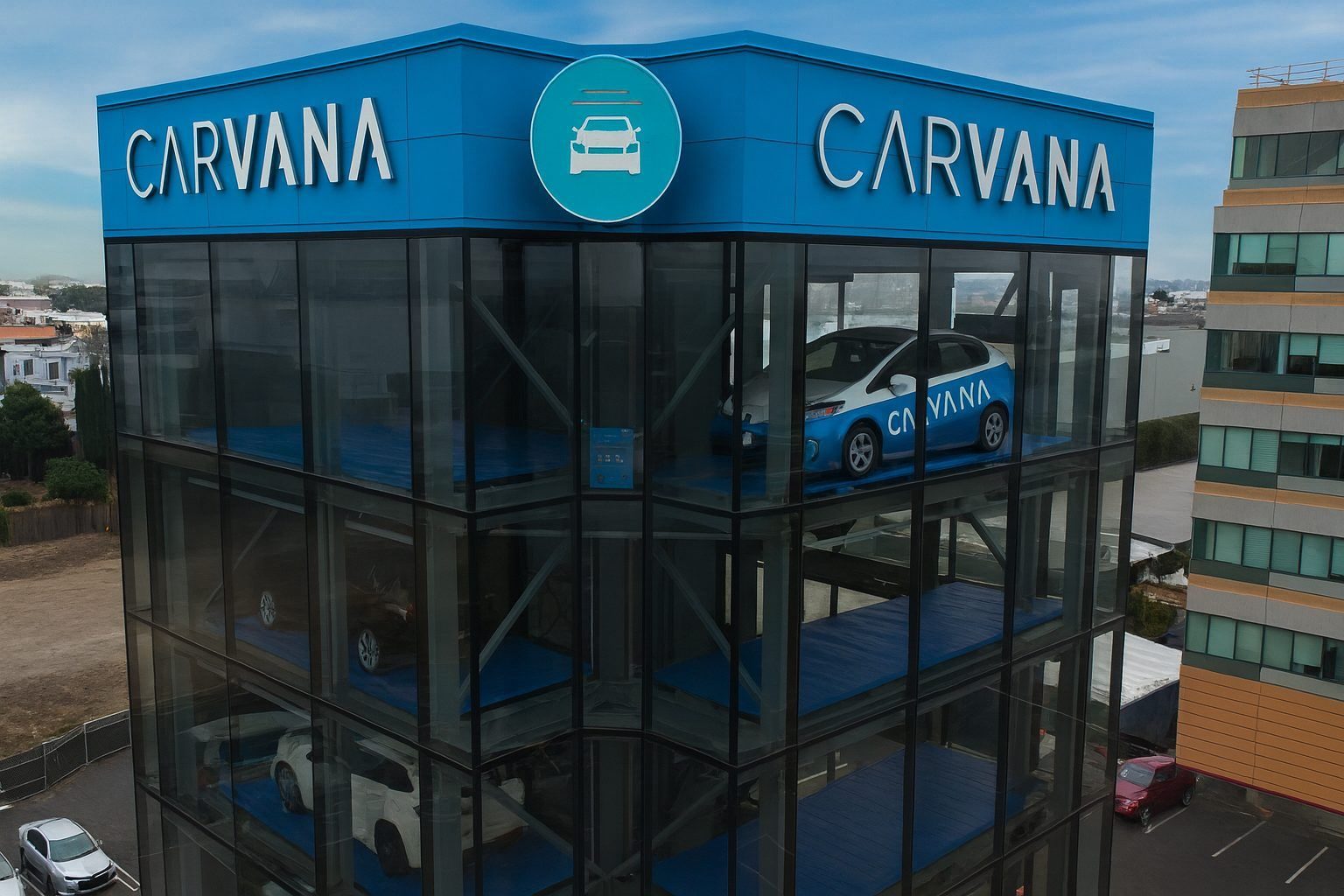On November 28, 2025, shares of Carvana Co. (NYSE: CVNA) continued their powerful 2025 rally, as investors leaned into a bullish narrative built on rate-cut optimism, record earnings, and aggressive analyst upgrades.
Carvana’s stock has climbed roughly 80%+ year-to-date, massively outperforming the broader market, and is now trading in the mid-$370s after a fresh leg higher into the final days of November. [1]
Below is a complete look at the key news flow around Carvana stock dated November 28, 2025, and how it fits into the bigger story for CVNA.
1. How Carvana Stock Traded on November 28, 2025
According to historical data, Carvana shares traded around the mid-$360s to mid-$370s on November 28, with the stock closing near $375.77, up from around $364 earlier in the week. [2]
Intraday coverage from market outlets also showed CVNA trading higher by roughly 4–5% on Friday afternoon, reflecting strong buying interest as investors piled into growth names benefiting from lower-rate expectations and recent positive analyst calls. [3]
Key takeaways from price action on Nov. 28:
- CVNA extended gains following earlier week upgrades and bullish commentary.
- The stock’s short-term bounce comes after a period of volatility and pullbacks earlier in November.
- Carvana continues to trade at levels that imply a high-growth, high-expectation story rather than a defensive value play.
2. November 28, 2025: What the News Said About CVNA
On November 28, 2025, several outlets highlighted Carvana’s recent move and re-rated outlook:
a) Zacks / Nasdaq: CVNA Up 17.1% Since Q3 Earnings
A report published on November 28, 2025 noted that Carvana shares are up about 17.1% since the company’s Q3 2025 earnings release, significantly outperforming the S&P 500 over that period. [4]
The piece emphasized:
- Carvana’s strong performance within the Internet – Commerce industry.
- The contrast between Carvana and peers like Wayfair, underscoring CVNA’s relative strength.
- Continued momentum more than a month after Q3 results, suggesting investors view the earnings beat as the start of a trend, not a one-off surprise.
b) Benzinga: Rate-Cut Hopes Fuel the Bull Case
Benzinga reported that on Friday afternoon (Nov. 28) Carvana stock was trading about 4–5% higher, with the move explicitly linked to:
- Growing expectations of Federal Reserve rate cuts, which tend to boost growth and high-beta names.
- Momentum from Wedbush’s upgrade earlier in the week, which raised Carvana’s price target to $400 and reiterated a bullish stance on the used-car platform. [5]
The article framed Carvana as a prime beneficiary of lower rates, since:
- Lower financing costs can support auto loan affordability for buyers.
- A more risk-on environment typically favors high-growth, tech-enabled retail platforms like Carvana.
c) Simply Wall St: Up 15.3% After Wedbush Upgrade
Another piece dated November 28, 2025 highlighted that Carvana’s stock is up roughly 15%+ following the Wedbush upgrade to “Outperform”. [6]
Key points in that coverage:
- Analysts expect Carvana to overtake CarMax in used-vehicle unit volume as soon as 2026, underscoring a potential changing of the guard in the used-car industry. [7]
- The upgrade cited solid growth in used-car sales, improving credit performance, and a strengthened competitive position.
- The recent pullback before the rally was framed as an overreaction, creating a buying opportunity for risk-tolerant investors.
d) MarketBeat: Carvana Named a “Top Retail Stock to Watch” on November 28
A MarketBeat screen of top retail names to watch on November 28, 2025 placed Carvana alongside Amazon, Alibaba, Walmart, and Costco, highlighting CVNA as one of the most notable retail stocks on investors’ radar that day. [8]
This inclusion reflects:
- Strong liquidity and trading interest in Carvana.
- Its status as a sentiment bellwether for high-growth retail and e-commerce within the U.S. market.
3. The Backdrop: Why Analysts Turned So Bullish Before November 28
Much of the November 28 news builds on developments from earlier in the month and late October.
Record Q3 2025 Results
On October 29, 2025, Carvana reported record third-quarter results: [9]
- Retail units sold: 155,941 (+44% year-over-year)
- Revenue: $5.647 billion (+55% YoY), an all-time quarterly high
- Net income: $263 million with a 4.7% net margin
- Adjusted EBITDA: $637 million (11.3% margin)
Strong demand for used vehicles—partly driven by tariffs and high prices in the new-car market—has been a significant tailwind.
Wedbush Upgrade and the “New Used-Car King” Narrative
In the week leading up to November 28, multiple outlets covered Wedbush’s upgrade of Carvana from Neutral to Outperform and the increase of its price target from $380 to $400. [10]
Analyst commentary included:
- Positioning Carvana as the likely “new used-car king” in the U.S. online used-car market. [11]
- Forecasts that Carvana could surpass CarMax in used-vehicle unit volumes by late 2026, ahead of prior expectations.
- The view that recent stock weakness (before the late-November rebound) was due more to sector worries and peer bankruptcies than to any deterioration in Carvana’s own fundamentals. [12]
This bullish sell-side shift is the backbone of the “up 15–17% since earnings” narrative dominating the November 28 coverage.
Technical Strength and Rating Upgrades
Investor’s Business Daily recently reported that Carvana’s Relative Strength (RS) Rating climbed into the low 80s, putting it ahead of most stocks in the market and near a potential breakout level—though the stock remains volatile and still shows a D Accumulation/Distribution rating, reflecting some institutional selling. [13]
4. Fundamentals and Valuation Snapshot
As of late November 2025:
- Carvana’s market cap is around $75–80 billion, with a P/E ratio in the low 80s, according to recent brokerage and trading platforms. [14]
- The stock has returned roughly 80–85% year-to-date, versus far lower gains for the S&P 500. [15]
- Analysts project continued double-digit revenue growth, though growth rates may moderate compared with the hyper-growth period of the early 2020s. [16]
In other words, Carvana is priced as a premium, high-growth, category-leader story. The November 28 articles collectively reflect that the market is, for now, willing to pay for that story—backed by both numbers (Q3 results) and narrative (market leadership, rate-cut tailwinds).
5. Key Bullish Drivers Highlighted in the November 28 News Flow
Putting all the November 28 coverage together, the bull case emphasized in the day’s articles looks like this:
- Powerful Post-Earnings Momentum
- Up ~17% since Q3 earnings, with the stock continuing to outperform both its peers and the broader market. [17]
- Analyst Upgrades and Higher Price Targets
- Wedbush’s $400 price target implies meaningful upside from late-November trading levels.
- Multiple publications echoed the idea that the recent pullback was an overreaction, framing the upgraded rating as an opportunity rather than a warning. [18]
- Potential Market Leadership Over CarMax
- Carvana is increasingly viewed as on track to overtake CarMax in used-car unit sales within roughly a year, signaling a shift in who leads the U.S. used-car industry. [19]
- Macro Tailwinds: Rate-Cut Hopes
- Expectations of lower interest rates support both consumer auto financing and investor appetite for high-growth stocks, and November 28 coverage explicitly cited rate-cut hopes as part of the bull case. [20]
- Sector-Relative Strength
- Carvana is repeatedly flagged as a top retail or internet-commerce name to watch, often grouped with giants like Amazon and Walmart in “top stock” screens. [21]
6. The Bear Case: Risks That Still Shadow the Rally
Despite the optimistic tone of much of the November 28 coverage, there are important risks that investors and traders should note:
- Rich Valuation
- A P/E in the 80s and a multi-billion-dollar market cap make Carvana sensitive to any disappointment in growth, margins, or credit quality. [22]
- Credit and Auto-Loan Risk
- While analysts highlight improving credit performance versus peers, the broader auto-loan environment remains fragile with rising delinquencies in parts of the market. [23]
- Volatility and Short-Seller Scrutiny
- Carvana has been a target for high-profile short sellers in the past, and critical reports have raised concerns on subprime exposure and accounting. Such scrutiny can resurface quickly if fundamentals wobble. [24]
- Insider Activity and Rule 144 Sales
- Around this period, filings show at least one insider planning to sell a block of 10,000 Carvana shares under Rule 144, with an estimated value in the mid-$3 million range. While not unusual for a stock that has risen sharply, insider selling can be interpreted as a signal of management’s view of current valuations. [25]
- Macro Sensitivity
- If rate-cut expectations are pushed back or macro conditions worsen, high-beta growth names like Carvana may see sharp downside swings.
7. What Investors Should Watch After November 28, 2025
For readers following Carvana through Google News and Discover, here are the key catalysts to monitor after the November 28 move:
- Next Federal Reserve Signals
- Any shift in rate-cut expectations will likely move CVNA quickly, in either direction.
- Holiday-Quarter (Q4) Updates
- The used-car market’s holiday-season demand and any trading updates from Carvana will be critical to confirming whether Q3’s record numbers are sustainable.
- Progress Toward Overtaking CarMax
- Watch upcoming Carvana and CarMax unit-sales data. If Carvana continues to close the gap—or surpasses CarMax on schedule—it will reinforce the “new used-car king” narrative.
- Credit Quality and Delinquencies
- Updates on auto-loan performance, charge-offs, and securitization spreads will matter as much as pure unit growth for long-term investors.
- Further Analyst Revisions
- Additional price target hikes or downgrades will give clues about whether Wall Street believes Carvana can grow into its rich valuation.
8. Bottom Line
On November 28, 2025, news coverage around Carvana stock painted a picture of a high-growth, high-volatility winner:
- Momentum: Up double digits since Q3 earnings and significantly outperforming the market. [26]
- Narrative: Potential future used-car market leader, buoyed by rate-cut hopes and bullish analysts. [27]
- Risk: A richly valued stock in a cyclical, credit-sensitive business, with volatility never far away. [28]
For traders, CVNA remains a high-beta vehicle for expressing views on rates, consumer credit, and the digitalization of auto retail. For long-term investors, November 28’s news flow underlines both the upside potential and the execution risk that come with betting on Carvana as the future king of the used-car market.
Disclaimer: This article is for informational and educational purposes only and does not constitute financial advice, investment recommendation, or an offer to buy or sell any securities. Always do your own research or consult a licensed financial advisor before making investment decisions.
References
1. finance.yahoo.com, 2. finance.yahoo.com, 3. www.benzinga.com, 4. www.nasdaq.com, 5. www.benzinga.com, 6. simplywall.st, 7. www.investors.com, 8. www.marketbeat.com, 9. investors.carvana.com, 10. www.barrons.com, 11. www.investopedia.com, 12. www.barrons.com, 13. www.investors.com, 14. robinhood.com, 15. finance.yahoo.com, 16. www.investors.com, 17. www.nasdaq.com, 18. www.barrons.com, 19. www.investors.com, 20. www.benzinga.com, 21. www.marketbeat.com, 22. robinhood.com, 23. www.barrons.com, 24. www.investors.com, 25. www.stocktitan.net, 26. www.nasdaq.com, 27. www.investopedia.com, 28. robinhood.com







